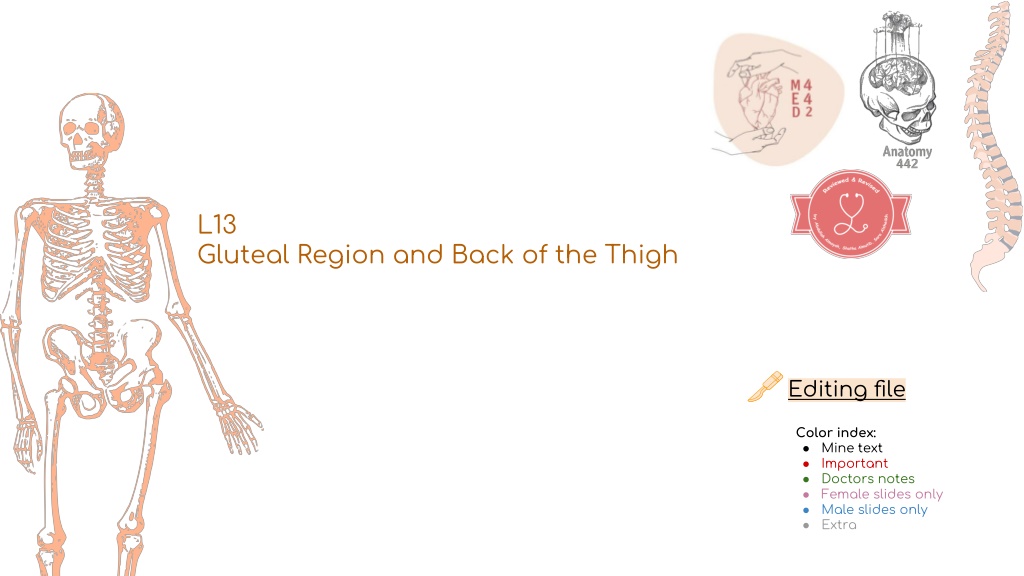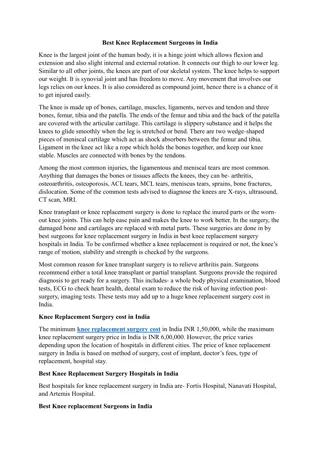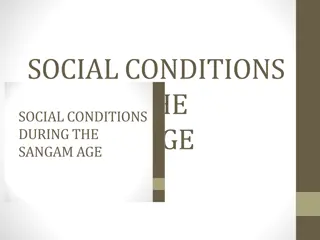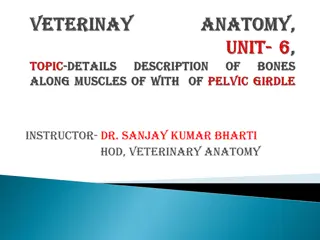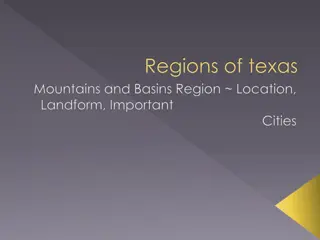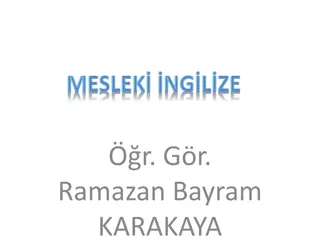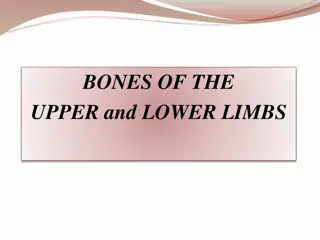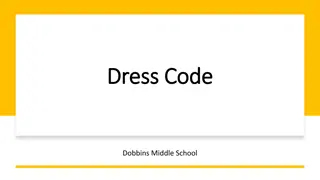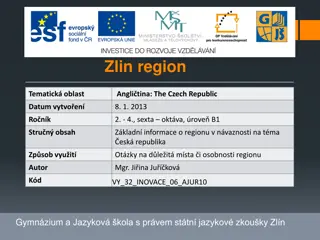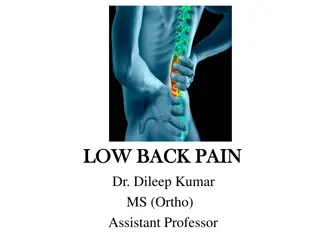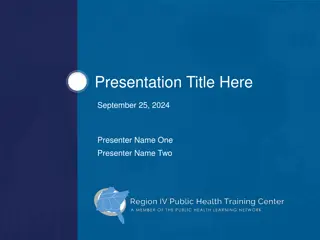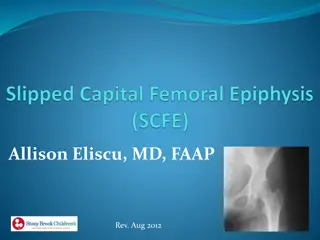Understanding the Gluteal Region and Back of the Thigh
Learn about the anatomy of the gluteal region and back of the thigh, including the muscles, nerves, vessels, and important structures passing through the greater and lesser sciatic foramen. Explore the origins and insertions of the Glutei muscles for a comprehensive understanding.
Uploaded on Oct 03, 2024 | 0 Views
Download Presentation

Please find below an Image/Link to download the presentation.
The content on the website is provided AS IS for your information and personal use only. It may not be sold, licensed, or shared on other websites without obtaining consent from the author. Download presentation by click this link. If you encounter any issues during the download, it is possible that the publisher has removed the file from their server.
E N D
Presentation Transcript
L13 Gluteal Region and Back of the Thigh Editing file Editing file Color index: Mine text Important Doctors notes Female slides only Male slides only Extra
OBJECTIVES identify Contents of the gluteal region: 3 Glutei muscles: Gluteus maximus, medius and minimus. Other 5 Small muscles: Piriformis, Obturator internus, Superior gemellus, Inferior gemellus and Quadratus femoris. Nerves & vessels. Foramina: 1-Greater Sciatic Foramen. 2-Lesser Sciatic Foramen. Back of the thigh: Hamstring muscles.
CONTENTS of gluteal region 1-Muscles 2-NERVES (all from sacral plexus): A- GLUTEI: 1. Sciatic nerve. 2. Superior gluteal n. 3. Inferior gluteal n. 4. Posterior cutaneous nerve of thigh. 5. Nerve to obturator internus. 6. Nerve to quadratus femoris. 7. Pudendal nerve. The Doctor said it not important The Pundendal 1. 2. 3. Gluteus maximus. Gluteus medius. Gluteus minimus. B- GROUP OF SMALL MUSCLES: 1. 2. 3. 4. 5. Piriformis. Obturator internus. Superior gemellus. Inferior gemellus. Quadratus femoris (all 5 muscles do lateral rotation).
3-VESSELS (all from internal iliac vessels): 1. Superior gluteal vessels. 1. Inferior gluteal vessels. 1. Internal pudendal vessels. The Doctor Said it is not important
Greater & lesser sciatic foramen Greater sciatic notch of hip bone is transformed into foramen by sacrotuberous & sacrospinous ligaments. Lesser sciatic notch of hip bone is transformed into foramen by Sacrotuberous & sacrospinous ligaments. Structures passing through Greater sciatic foramen : Structures passing through Lesser sciatic foramen : Piriformis muscle.(landmark for greater sciatic foramen) -Tendon of obturator internus. Above piriformis: -Nerve to obturator internus. -Superior gluteal nerves & vessels. -Pudendal nerve. Important you should know what passes through and which below and above -Internal pudendal vessels. Below piriformis: (no sciatic nerve) -Inferior gluteal nerves & vessels. -Sciatic nerve. -Posterior cutaneous nerve of thigh. -Nerve to quadratus femoris. Tendon of obturator internus only in lesser sciatic foramen while the rest of them can goes into Greater Sciatic foramen -Nerve to obturator internus. -Pudendal Nerve. -Internal pudendal vessels.
Glutei Muscles ORIGINS: Insertion: Gluteus minimus: Anterior part of the gluteal surface of ilium Gluteus medius: Middle part of the gluteal surface of ilium. Gluteus maximus: Posterior part of the gluteal surface of ilium. Main origin of gluteus maximus: Back of sacrum & coccyx & back of Sacrotuberous ligament Gluteus minimus: anterior surface of the greater trochanter Gluteus medius: lateral surface of the greater trochanter Gluteus maximus: Main insertion: iliotibial tract Other insertion: gluteal tuberosity of the femur. 1. 2.
NERVE SUPPLY & ACTION of Gluteus Muscles Gluteus medius & minimus: Nerve supply: Superior gluteal nerve. Action: Abduction & Medial rotation of hip joint. Gluteus maximus: Nerve supply: Inferior gluteal nerve. Action: Extension & lateral rotation of the hip joint. Through its attachment to iliotibial tract, it stabilizes the femur on the tibia during standing.
Small muscles 4-Piriformis: Origin: Pelvic surface of middle 3 sacral vertebrae. Insertion: Greater trochanter. Nerve supply: Anterior rami of S1,2. 1-Obturator Internus: Origin: Side wall of the pelvis. Insertion: Greater trochanter. Nerve supply: Nerve to obturator internus. Nerve Supply : 2,3-Superior & Inferior Gemelli: Origin: Upper and lower part of lesser sciatic notch respectively. Insertion: Into tendon of obturator internus. Nerve supply: Superior gemellus: nerve to obturator internus. Inferior gemellus: nerve to quadratus femoris. 5-Quadratus femoris: Origin: Ischial tuberosity. Insertion: Quadrate tubercle. Nerve supply: Nerve to quadratus femoris. Action: All have SIMILAR ACTION: Lateral rotation of the hip joint. Control movement of the hip joint.
Nerves in Gluteal Region Helpful video Helpful Video Superior gluteal Nerve Inferior gluteal Nerve Nerve to quadratus femoris Nerve Posterior cutaneous nerve to thigh Sciatic nerve Nerve to obturator internus
NERVES SUPERIOR GLUTEAL NERVE: INFERIOR GLUTEAL NERVE; NERVE TO QUADRATUS FEMORIS Course : Passes through GSF , Below Piriformis Course: Passes through GSF , Below Piriformis Course: -Passes through GSF , Above Piriformis Branches: -Muscular to Quadratus Femoris & inferior gemellus Branches: Gluteus Maximus Branches: -Muscular to Gluteus Medius,Minimus & tensor fasciae lata muscle. -Articular to Hip Joint -Articular to Hip Bone GSF= Greater Sciatic Foramen
POSTERIOR COMPARTMENT OF THE THIGH (HAMSTRINGS) : Helpful video Helpful Video Biceps femoris Semitendinosus Semimembranosus Ischial part of adductor magnus Blood supply : branches of profunda femoris artery nerve supply : sciatic nerve All the posterior compartment of the thigh will be supplied by tibial part of the sciatic EXCEPT the short head of biceps femoris will be supplied by the common peroneal part of the sciatic Adductor Magnus have two parts: 1- Adductor part (Medial compartment of the thigh) 2- Hamstring part ( Posterior compartment of the thigh) - Each have different action and different nerve supply.
Biceps Femoris Semitendinosus Origin : Origin : 1. long head : from the ischial tuberosity Ischial tuberosity 1. short head : from the linea aspera Insertion : Upper part of the medial surface of the shaft of the tibia (SGS) Insertion : head of fibula S= Sartorius - G=Gracilis - S=Semitendinosus Tibia Nerve supply : Nerve supply : Tibial sciatic nerve 1. long head : tibial part of the sciatic nerve Action : 1. Flexion of the knee joint 2. Medial rotation of the leg 3. Extends the thigh at the hip joint 1. short head : common peroneal part of the sciatic nerve Action : 1. flexion of knee. 2. Lateral rotation of flexed leg. 3.Long head extends the hip.
Muscles Semimembranosus Adductor magnus Origin : Ischial tuberosity Origin : Ischial ramus and ischial tuberosity Insertion : posterior surface of the medial condyle of the tibia Insertion : Adductor tubercle of the medial condyle of the femur It forms the oblique popliteal ligament, which reinforces the capsule on the back of the knee joint. Nerve supply : Tibial part of the sciatic nerve Nerve supply : Tibial part of the sciatic nerve Action : Extends the thigh at the hip joint Action : 1. Flexion of the knee joint 2. Medial rotation of the leg 3. Extends the thigh at the hip joint
The Doctor said The Nerve Supply (sciatic nerve) it will be explained in details in Sciatic Nerve Lecture
MCQs: Q1 Structures that pass through Greater sciatic foramen a A&B D A Tendon of obturator internus B C Piriformis muscle Pudendal nerve Q2 Action of Gluteus maximus A D B C Flexion Medial rotation none Extension Q3 Nerve supply of Inferior gemellus nerve to quadratus femoris. nerve to obturator internus. A D B C Inferior gluteal nerve Anterior rami of S1,2 Q3;A Q2;B Q1;D
MCQs: The origin of the long head of biceps femoris Q4 D A B C From the ischial ramus From the ischial tuberosity From the linea aspera None of the above Q5 Nerve that supply the short head of biceps femoris common peroneal part of the s sciatic nerve B A D C Inferior gluteal nerve Posterior cutaneous nerve tibial part of the sciatic nerve Q6 Action of the semitendinosus A D B C Flexion of the knee joint Medial rotation of the leg All of the above Extends the thigh at the hip Q6. D Q5. A Q4. B
Done by the amazing team Team leaders: Arwa Alghamdi Deema Aljuribah Razan Alnufaie Team leaders: Mishal Alsuwayegh Mohammed Alghamdi Members: Members: Nasser Alghaith Saad Almogren Azzam Abdullah Alotaibi Hassan Ali Alabdullatif Rayan Alotaibi Mohammed Nasser Mohammed Fahad Mohammed Majed Abdulkarim Salman Saleh Aldeligan Othman Aldraihem Faisal Alomar Abdullah Alturki Othman Alabdullah Omar Alkadhi Abdullah Ali Meshari Alshathri Yazeed Alsanad Fahd Mobaireek Emad Almutairi Noura Bin hammad Najla aldhbiban Razan alasmari Roaa alharbi Raghad Mohammed Shaden albassam Waha Almathami Walaa AlMutawa Yara Ameer Alalwan Aljazi Albabtain Atheer Alkanhal Arob Alasheikh Ajwan Aljohani Deema alqahtani Dena Alsuhaibani Jana Alhazmi Kadi aldosari Mashael Alasmari Thanks to Faisal Alomar for his design of the team logo anatomyteam442@gmail.com
